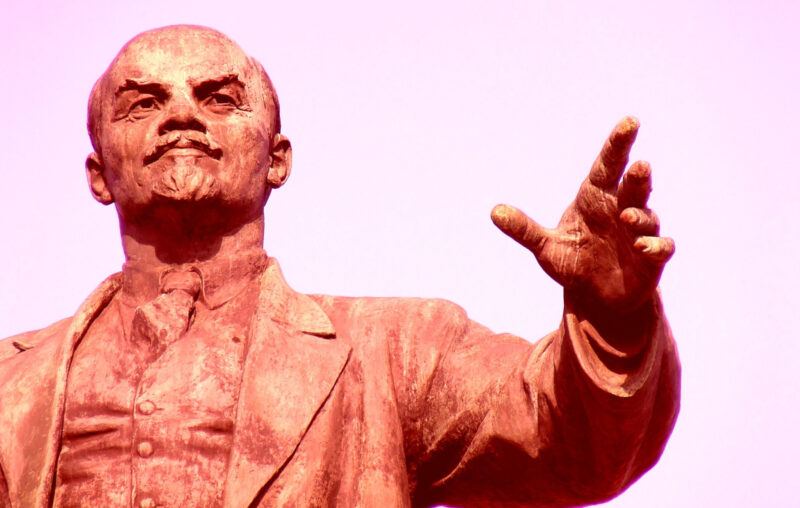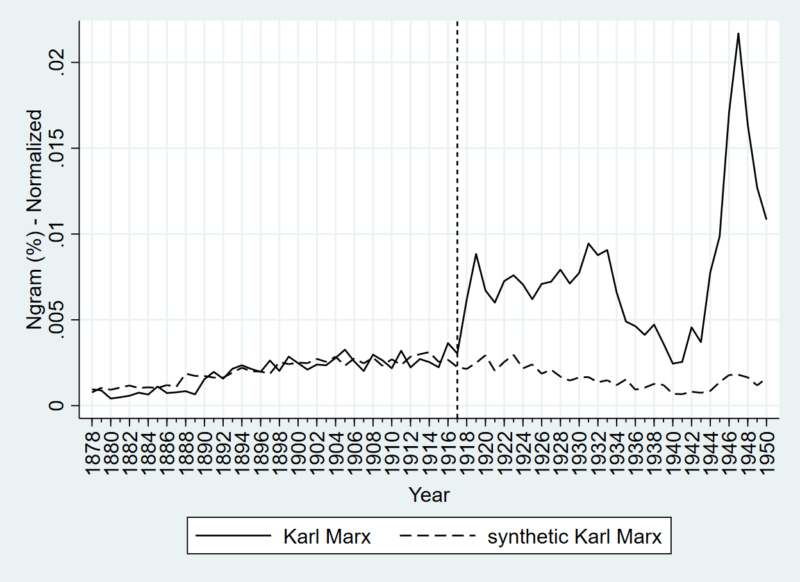When Lenin Read a Book on Marx

I expected pushback against the thesis of my paper (co-authored with Michael Makovi) “The Mainstreaming of Marx: Measuring the Effect of the Russian Revolution on Karl Marx’s Influence” from Marxists and other followers of the socialist philosopher.
In the paper, we use Google Ngram and a separate newspaper database to track textual mentions of Karl Marx’s name over time. Our major finding is that the Soviet revolution of 1917 essentially revitalized Marx’s reputation by turning him into a household name.
By comparison to his post-1917 citations, Marx was a relatively obscure figure at the time of his death in 1883. In the decades that followed, Marx was primarily known among other radical socialist activists (usually as the leader of one of many contesting factions in the socialist world) or for when the mainstream of the economics profession rebutted his arguments about the Labor Theory of Value. For example, Philip Wicksteed, Alfred Marshall, and Eugen von Boehm-Bawerk penned marginalist critiques of Marx’s system in the late 19th century. Their dissections of his system struck a devastating blow, effectively rendering Marxian economics obsolete by the turn of the century.
After our article appeared online, several respondents invoked the history of the Sozialdemokratische Partei Deutschlands (SPD) as a counterargument, insisting that it proved Marx’s mainstream prominence before the Bolsheviks took up the cause. A large labor-centered political party in Germany, the SPD was under the leadership of Marxist theorists August Bebel, Eduard Bernstein, and Karl Kautsky (the latter something of a designated successor to Friedrich Engels) between 1891 and the outbreak of World War I. If their argument holds, Kautsky et al. would have made Marx a household name before the Soviet revolution.
We implicitly looked at this theory in our original paper, finding little evidence of a boost in Marx’s citations in German-language Ngrams during the pre-1917 years. At the supposed peak of Marx’s influence in the SPD from 1891 to 1913, his German-language Ngrams show few signs of movement. By comparison, German references to Marx take off after 1917 just as they do in English Ngrams.

Nonetheless, a string of Twitter threads – often laced with obscenities and similar derision – accused us of neglecting the SPD’s role in the “intellectual history” of disseminating Marxism. We anticipate releasing a more detailed empirical analysis of this counterargument in the near future, but for the time being, let’s take a closer look at the argument that Marx went mainstream in the SPD years, beating the Soviets by a decade or more.
A significant complication to the SPD counterclaim comes from Karl Kautsky himself. In his late-life memoirs, the SPD’s in-house theorist of all-things-Marx penned a fascinating concession: “In the party I was made aware of Marx’s Capital, the Bible of Socialism as it was known. Only a few had read it, and even fewer were those who understood it.”
The implications of Kautsky’s statement do not bode well for the SPD counterargument. If anything, it confirms why Marx’s Ngram patterns in German-language texts were relatively flat before spiking sharply in 1917. Kautsky and his colleagues may have been writing explicitly Marxist works of high-minded socialist theory, printing and translating Marx’s books, and developing a system of Marxist political philosophy among their intellectual circles. Still, the SPD’s rank-and-file membership didn’t read or take an interest in the same.
Evidence for our interpretation and against the SPD counterargument comes from an unlikely source: the late Marxist historian Eric Hobsbawm (1917-2012). In addition to his historical writings, Hobsbawm is well known for writing the scholarly introduction to one of the most widely used editions of Marx and Engels’s Communist Manifesto. He gives a detailed historical background of how the Manifesto was published and disseminated over the decades after its composition in 1848. Hobsbawm also looks specifically at the SPD leadership’s role in failing to spread Marx’s theories to their rank-and-file membership. He writes:
This uneven geographical distribution did not only reflect the uneven development of the socialist movement, and of Marx’s own influence, as distinct from other revolutionary ideologies such as anarchism. It should also remind us that there was no strong correlation between the size and power of social-democratic and labour parties and the circulation of the Manifesto. Thus until 1905 the German Social-Democratic Party (SPD), with its hundreds of thousands of members and millions of voters, published new editions of the Manifesto in print runs of not more than 2,000–3,000 copies. The party’s Erfurt Programme of 1891 was published in 120,000 copies, while it appears to have published not many more than 16,000 copies of the Manifesto in the eleven years 1895 to 1905, the year in which the circulation of its theoretical journal, Die Neue Zeit, was 6,400. The average member of a mass Marxist social-democratic party was not expected to pass examinations in theory.
Hobsbawm looks at the patterns in other countries, finding a “scattering of Marxist sects in the Anglo-Saxon world, operating on the left flank of such labour and socialist parties as existed.” These groups were few, existing almost entirely on the periphery of the political spectrum. Hobsbawm thus concludes about even the readership of the comparatively accessible Communist Manifesto that they “were almost certainly not a representative sample of their membership” in the various associated labor parties and political organizations.
When did this pattern change, and when did Marx’s most accessible work finally gain salience among a larger readership? Hobsbawm provides us with an answer:
This situation changed after the October Revolution – at all events, in the Communist Parties. Unlike the mass parties of the Second International (1889–1914), those of the Third (1919–43) expected all their members to understand – or at least to show some knowledge of – Marxist theory. The dichotomy between effective political leaders, uninterested in writing books, and the ‘theorists’ like Karl Kautsky – known and respected as such, but not as practical political decision-makers – faded away. Following Lenin, all leaders were now supposed to be important theorists, since all political decisions were justified on grounds of Marxist analysis – or, more probably, by reference to the textual authority of ‘the classics’: Marx, Engels, Lenin and, in due course, Stalin. The publication and popular distribution of Marx’s and Engels’s texts therefore became far more central to the movement than they had been in the days of the Second International. They ranged from series of the shorter writings, probably pioneered by the German Elementarbücher des Kommunismus during the Weimar Republic, and suitably selected compendia of readings, such as the invaluable Selected Correspondence of Marx and Engels, to Selected Works of Marx and Engels in two – later three – volumes, and the preparation of their Collected Works [Gesamtausgabe]; all backed by the – for these purposes – unlimited resources of the Soviet Communist Party, and often printed in the Soviet Union in a variety of foreign languages.
Next, Hobsbawm directly anticipates another point we make in our paper. The Soviet Union’s mass publication and promotion of Marx’s works also filtered into other countries, as socialist and Marxist organizations copied the strategy provided by Lenin’s Bolsheviks. In short order, this promotional frenzy injected Marx into the mainstream of the university system as academics took up his works and began teaching from them. Hobsbawm continues:
The Communist Manifesto benefited from this new situation in three ways. Its circulation undoubtedly grew. The cheap edition published in 1932 by the official publishing houses of the American and British Communist Parties in ‘hundreds of thousands’ of copies has been described as ‘probably the largest mass edition ever issued in English’. Its title was no longer a historical survival, but now linked it directly to current politics. Since a major state now claimed to represent Marxist ideology, the Manifesto’s standing as a text in political science was reinforced, and it accordingly entered the teaching programme of universities, destined to expand rapidly after the Second World War, where the Marxism of intellectual readers was to find its most enthusiastic public in the 1960s and 1970s.
Few, if any, Marxists today would dispute Hobsbawm’s intellectual stature as one of the preeminent Marxist historians of the last century. Nor have they thus far challenged his analysis in the above-noted essay, which appears in multiple classroom editions of the Communist Manifesto – one of the most frequently assigned texts in university syllabi today. It is, therefore, no small irony that Hobsbawm’s qualitative investigation of Marx’s dissemination and spread now finds empirical validation in the unlikeliest of sources: our econometric analysis of the Soviet revolution’s effects on Marx’s citation patterns after 1917.










